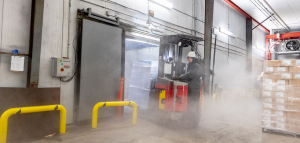How Does a Cold Storage Warehouse Work?
Cold storage warehouses play a critical role in the storage and preservation of perishable goods, ensuring that items like food and pharmaceuticals remain safe for consumption. These specialized facilities are designed to maintain low temperatures, allowing businesses to store products for extended periods without compromising their quality. In this article, we will delve into the inner workings of a cold storage warehouse, exploring the technology, processes, and benefits that make them essential in today’s supply chain. How does a cold storage warehouse work?
Understanding the Basics of Cold Storage Warehouses
Temperature Control
The primary purpose of a cold storage warehouse is to maintain a controlled environment where temperatures are consistently kept at a low level, typically ranging from -20°C to 4°C (-4°F to 39.2°F), depending on the specific needs of the stored products. This is achieved through a combination of insulation, refrigeration systems, and advanced temperature monitoring technology.

Insulation
Insulation is a fundamental component of a cold storage warehouse, as it helps prevent heat from entering the facility and maintains the desired temperature inside. Thick walls and ceilings, often constructed with materials like foam or fiberglass, provide a barrier against external temperature fluctuations.
Refrigeration Systems
Refrigeration systems are the heart of a cold storage warehouse. They work tirelessly to remove heat from the facility’s interior, ensuring that the temperature remains within the specified range. These systems employ a variety of techniques, including compression and evaporation, to achieve this goal. Refrigerants like ammonia, carbon dioxide, or hydrofluorocarbons (HFCs) are commonly used to facilitate the cooling process.
The Role of Automation
Conveyor Systems
Cold storage warehouses are often equipped with conveyor systems that efficiently transport products from one area to another. These conveyor belts are designed to work in low-temperature environments and are essential for streamlining the movement of goods.
Automated Storage and Retrieval Systems (AS/RS)
AS/RS systems are a key feature of modern cold storage warehouses. These automated systems use robotic arms and high-rise shelving to store and retrieve products quickly and accurately. AS/RS not only save space but also reduce the risk of human error in handling products. Learn how building a cold storage warehouse begins here.
Inventory Management
Advanced software and automation tools are used for real-time inventory management. These systems track the location and quantity of products within the warehouse, ensuring efficient stock rotation and minimizing the risk of spoilage or product loss.
Safety and Quality Assurance
Monitoring and Alarms
Constant monitoring is crucial to maintaining the integrity of the cold storage environment. Sensors and alarms are strategically placed throughout the warehouse to detect any deviations in temperature or humidity. When an issue is detected, alarms trigger immediate corrective actions to prevent spoilage.

Quality Control
Cold storage warehouses often have quality control protocols in place to inspect products for any signs of damage, contamination, or deterioration. This ensures that only safe and high-quality goods are distributed to consumers.
Benefits of Cold Storage Warehouses
Extended Shelf Life
One of the primary benefits of cold storage warehouses is the ability to extend the shelf life of perishable goods. This is especially critical for the food industry, where fresh produce and frozen products need to remain viable for extended periods.
Reduced Waste
By maintaining a controlled environment and closely monitoring inventory, cold storage warehouses help reduce waste. Businesses can avoid product spoilage and disposal costs, making their operations more sustainable and cost-effective.
Efficient Distribution
Cold storage warehouses play a crucial role in the efficient distribution of products to retailers and consumers. With advanced automation and inventory management, these facilities can expedite the order fulfillment process, ensuring that products reach their destination in optimal condition.
Conclusion
Cold storage warehouses are indispensable components of the modern supply chain, providing the infrastructure and technology needed to preserve perishable goods. Through precise temperature control, automation, and quality assurance measures, these facilities ensure that consumers can enjoy safe and fresh products year-round. As technology continues to advance, cold storage warehouses will only become more efficient and essential in meeting the growing demands of our globalized world.

Recent Comments